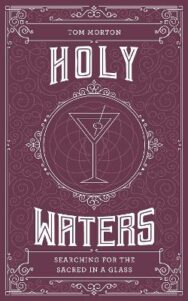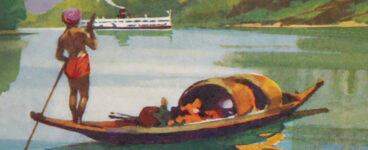‘I once conducted a tongue-very-much-in-cheek ‘guided tasting’ that involved Scotsmac, Buckfast Tonic Wine, Irn Bru and English St George’s Whisky. It’s fair to say that the audience left discombobulated and desperately seeking a proper drink. ‘
Tom Morton has travelled the world in search of the finest drams that the world has to offer; Holy Waters is his journey to the spiritual heart of whisky, sake, rum, and many more drinks to list. Revelling in the lore and mysteries, the relationships between human and landscape and beyond, it’s a celebration of cultures and artisan craft. Read an extract from the book below.
Holy Waters: Searching for the sacred in a glass
By Tom Morton
Published by Watkins Publishing
Largs is a small holiday town on the Firth of Clyde, about 30 miles from Glasgow, and it has been one of my favourite places since I first tasted home-made Italian ice cream and smelled the tang of salt, vinegar and fishy chip fat on the evening air.
I have never consumed an alcoholic drink in Largs, but I have worshipped in the local Gospel Hall, sung choruses at open-air meetings and eaten large quantities of Nardini’s ice cream and fish and chips, washed down with Barr’s Irn Bru. I have gazed at The Pencil, the monument to Scottish King Alexander III’s defeat of King Haakon of Norway’s forces in 1263, the battle that brought to an end Viking harassment of Scotland’s mainland, though not Norse influence over the islands.
Vikings are still part of Largs’s lore and street geography, pub names and touristic mythology. But long gone is the item that planted the romance of the Vikings in my head and heart as a youngster – the gigantic facsimile of a Norse war galley that used to jut from an Art Deco building that was once the 1300- seat Viking cinema. We kids would shriek with excitement each time we passed that fake boat’s ferocious-looking dragon’s head prow, but before long the building was the headquarters and bottling plant of J H Wham and Son, who produced a truly horrible blend of sweet South African wine and Scotch Whisky called Scotsmac. It was a favourite of schoolboys and girls on an illicit bender as it was cheap and effective; alcoholics liked it too. In fact, it was not unlike the much mentioned Buckfast Tonic Wine or other electric soups of Scottish industrial culture. It was affectionately known as Wham’s Dram or sometimes Bam’s Dram.
Scotsmac is no longer available for sale. It had gone through several owners by the time it vanished from the cheaper British supermarkets’ shelves in 2018, and it’s 15 per cent alcohol, viciously hangover-inducing axe-blow to head and heart, thankfully, became a thing of the past. I once conducted a tongue-very-much-in-cheek ‘guided tasting’ that involved Scotsmac, Buckfast Tonic Wine, Irn Bru and English St George’s Whisky. It’s fair to say that the audience left discombobulated and desperately seeking a proper drink.
And that was it for me and Vikings really, once childhood has departed. Or so I thought. Then, for reasons spelled out in two other books, I ended up living in the Shetland Islands, that northernmost of British archipelagos halfway to Scandinavia, and Vikings came rampaging back into my life.
Holy Flight – Tasting Notes
Lerwick Brewery Blindside Stout
Founded in 2012, the Lerwick Brewery is fairly new, and has been the most northerly brewery in the UK since the closure of Valhalla in Unst, Shetland’s northernmost island. This is my favourite of all their beers; it’s a highly successful dark IPA that conjures up for me memories of the night in Cork when I encountered Murphy’s Stout for the first time.
Colour: Dark ruby brown
Nose: Malty and dark with lots of wedding-cake fruitiness.
Palate: Lighter than you’d expect from that blackness, roasted nuts and burned toast. It has a great deal of character.
Finish: Small bubbles, so doesn’t ransack your tastebuds; leaves a fairly smoothe aftertaste.
Scapa Skiren Single Malt
Skiren is Old Norse for the sparkling summer light you get in Orkney, where this whisky comes from. The Scapa distillery is right next to the sea, not too far from its competitor Highland Park in Kirkwall, and its products have often been dismissed as less characterful than its better-known local cousin. Notably by myself. Recently, I bought a bottle in the community shop that sits right in front of the St Rognvald Hotel, and I have to say I was very impressed.
This has been aged only in ‘first fill’ American oak (that would be barrels bought in kit form from the USA, where it is illegal to re-use barrels that have had whiskey in them previously) and it has a delightful, supple smoothness, lacking the sweet sherry oak notes of Highland Park but with a gloriously assured fruitiness and a charcoal tang from the treatment the American oak casks would have had across the Atlantic – all are charred internally to add character to the whiskey made there.
Colour: Sandy, light gold
Nose: Salt and sweetness, a walk along a storm-tossed beach on a cloudy day. Firm leathery notes with a hint of seaweed.
Palate: This is a really assured whisky, with the merest hint of heathery island influence. There is a salt shoreline aspect, but you could be forgiven for thinking this was a Speyside malt. The American oak makes it creamy and smooth.
Finish: Burn-free and long lasting, vanilla pods and gorse bushes in the snow. Very nice indeed.
Lindisfarne Original Mead
Lindisfarne, or Holy Island, is reached by tidal causeway from the Northumberland coast in the north of England. The island is steeped in the Celtic, Roman and Viking traditions, and it’s 238 thought it was first settled by monks who arrived with St Aidan, via Iona. The monks brought their expertise in both beekeeping and the uses of honey to make mead, and this mead was seen by the locals, understandably, as holy – an elixir that could be used to heal the sick, promote long life and provide a little bit of comfort from the ferocious North Sea weather.
Lindisfarne Mead as sold today from the winery on the island comes in three varieties – original, dark, pink and spiced – and includes more than just fermented honey. It uses what’s thought to be a Roman, rather than Viking or Celtic recipe. So in addition to honey, ingredients include water, wine and raw alcohol, as well as various herbs and spices. The taste is described by the makers as ‘light, smooth, with a sharp aftertaste – reminiscent of a sweet-wine.’ The label is based on the artwork of the Lindisfarne Gospels, which were created at Lindisfarne Priory on the island in the 7th century.
Put it this way: it’s better than Buckfast Tonic.
Colour: Yellow-oaky gold
Nose: A smell of honeysuckle in the sunshine.
Palate: Slightly tart with honey coming in.
Finish: Cinnamon and ginger with a substantial, sweet punch.
Holy Waters: Searching for the sacred in a glass by Tom Morton is published by Watkins Publishing, priced £12.99.
ALSO IN THIS ISSUE

 Carrie Kills a Man: A Q & A With Carrie Marshall
Carrie Kills a Man: A Q & A With Carrie Marshall
‘Most of all, I hope people will understand that we’re not an issue, an ideology or a fad; we’re jus …














